182d General Hospital Unit History
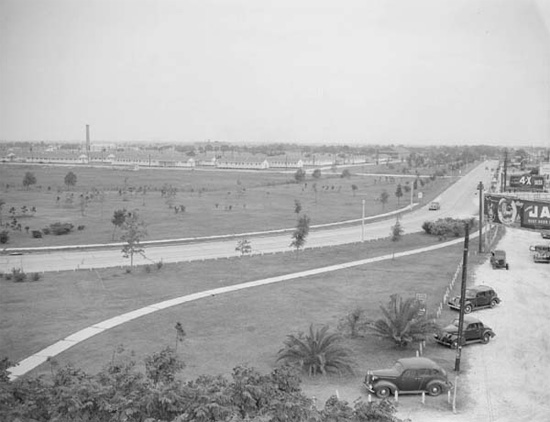
Partial view of LaGarde General Hospital, New Orleans, Louisiana. The temporary home and training site where the 182d General Hospital was activated and trained before moving overseas to the European Theater.
Introduction & Activation:
Life of a US Army Hospital in the European Theater of Operations went on surprisingly much like that in America. Except for close home and community contacts, hospital personnel found themselves going through most of the daily tasks of a regular ‘Army Post’ in the Zone of Interior. Problems of morale and personnel were sometimes more acute, and flow of requisitions and supplies could affect daily field operations, but they were expected to be so, and plans were made accordingly while the unit was still training in the United States. Farsighted planning, in fact, throughout the entire hospital unit made achieving of the primary mission much more successful!
The 182d General Hospital was officially activated while training at LaGarde General Hospital in Louisiana. We unfortunately were unable to find the actual date of constitution and activation, which are lacking in the official reports dated 1944. It can however be assumed that this took place some time in 1943 (as per Special Orders No. 49, dated 20 February 1943 a number of Officers were relieved from assignment to the QMRTC, Camp Lee, Petersburg, Virginia, and instructed to report not later than 10 March 1943 to the 182d General Hospital at the station where subject unit was to be activated. Their assignment was designated as: 182d General Hospital, Services of Supply, Unit Training Center, New Orleans, Louisiana –ed).
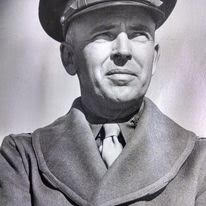
Photograph of Colonel Charles Lee Kirkpatrick (MC) aboard the Athlone Castle en route to England. Photograph taken 29 March 1944.
Training:
During the months of March and June 1943, a number of Officers arrived at the New Orleans Staging Area, Louisiana, for assignment and duty at the 182d General Hospital, while others already on duty were reassigned to Officers’ quarters. They included:
Lt. Colonel Charles L. Kirkpatrick, MC, O-18642
Major Dale C. McCarthy, MC, O-311714
Major Ralph D. Watkins, DC, O-241896
Captain William A. Cooper, MC, O-404378
Captain Anthony V. Palma, SnC, O-346304
1st Lieutenant Desider B. Ecker, MC, O-1545304
1st Lieutenant Edward D. McKenna, MAC, O-1545304
1st Lieutenant Stephen C. Meigher, MC, O-369590
1st Lieutenant Irving G. Rosefield, SnC, O-490436
2d Lieutenant Joseph R. Devine, MAC, O-1545429
2d Lieutenant Melvin D. Gulley, MAC
2d Lieutenant Paul D. Hass, QMC, O-1588035
2d Lieutenant John V. Richardson, Sr., QMC, O-1588250
A 2-day bivouac training under the responsibility of Major Dale C. McCarty, MC, O-311714, Training Officer took place 18 – 19 June 1943, including a number of special activities such as:
| Friday 18 June 1943 0800-0900 > march to bivouac area with full field pack 0900-1000 > unit activities 1000-1200 > camouflage 1300-1700 > prepare night march 1710 > assembly 1715 > retreat 1900-2300 > night road march |
Saturday 19 June 1943 0800-0830 > calisthenics 0830-0900 > drill 0900-1000 > prepare inspection 1000-1100 > inspection 1100-1200 > medical records 1300-1700 > toughening |
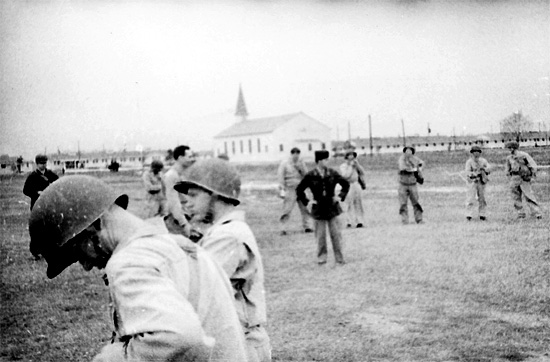
Gas Mask Training and Instruction by 1st Lieutenant Paul D. Hass, LaGarde General Hospital, New Orleans, Louisiana, 1943. Courtesy of Chris Clippinger.
The first two and a half months were devoted to training and preparations for service overseas. While the unit went about its usual camp duties at LaGarde General Hospital, New Orleans, Louisiana (wooden cantonment-type of hospital installation, designated a General Hospital by Letter AG 322.3, M (Ret) 9 January 1941, M-C, dated 11 February 1941, with an authorized bed-capacity for 1,176 patients, specialty general & orthopedic surgery, and psychiatry –ed), the important details which required special attention, worthy of recording, included final Inspector General inspection, arrival of assigned personnel in Nurse and Officer categories, arrival of last minute replacements to complete Enlisted strength, and fulfilments of an Eighth Service Command training requirements of a week’s bivouac under simulated battle conditions.
The training phase of the 182d General Hospital’s history reached a high level beginning with November 1943 and continuing down to the end of February 1944. Not only was a strong emphasis placed upon all principles of Basic Training, but those subjects concerned with combined training were stressed as well. Each week saw an especially determined effort to learn, routinize, and test a certain subject, for instance one like heavy tent pitching. Every Enlisted Man and Officer took part in raising and lowering heavy tentage, speed drills were held, men were shifted from position to position, and tents were put up and taken down many times during a single afternoon. Care of tentage equipment and rolling, packing, and storing were auxiliary features of the course. All of these tricks were then put into play during the bivouac in February. Special attention was given to chemical warfare with repeated drills, not only did everyone go through an improvised gas chamber, but numerous simulated attacks with tear gas were also conducted at nights. CWS courses and exercises were conducted under the direction of Lieutenant John V. Richardson, CWS.
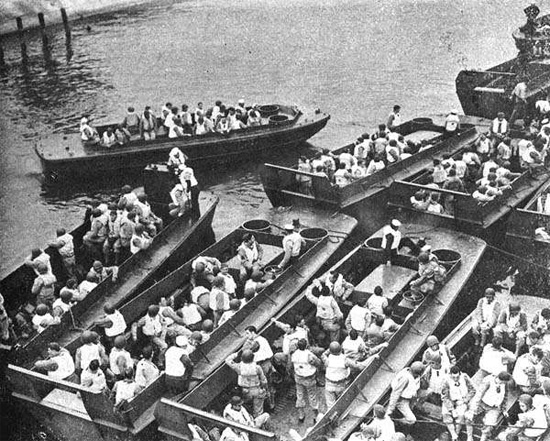
182d General Hospital personnel ready for training on Lake Pontchartrain, Louisiana. Top left, an LCP (L) passes several LCVPs at the Higgins Boat Operations & Marine Engine Maintenance School, Lake Pontchartrain. The landing craft are crewed by US Navy and US Coast Guard students. Official designation: Landing Craft, Personnel, Large, and Landing Craft, Vehicle, Personnel.
The peak of all training came during the week of 7 February 1944 accompanied with a bivouac. The area chosen was the Boy Scouts of America Camp at Slidell, Louisiana, on the north shore of Lake Pontchartrain. Men and Officers on furlough and on leave were all called back to participate. With the cooperation of the “Higgins Industries” (New Orleans), a fleet of 23 landing craft was put at the Hospital’s disposal for transportation across the lake. At 0730 on the morning of 7 February, troops marched out of the Hospital area at LaGarde to the Higgins Landing Stage on new Basin Canal. There, all troops pertaining to the 182d General Hospital + 682d General Hospital Complementary Unit embarked under supervision of Higgins Company personnel. Upon arriving at the camping site, groups of EM and Officers were detailed for specific jobs in connection with settling the grounds. 1st Lieutenant Paul D. Hass, QMC, established a unit Supply Depot; 1st Lieutenant John V. Richardson, Sr., CE, a Motor Pool; Captain Charles C. Chumbley, DC, supervised erection of tents; 1st Lieutenant Melvin D. Gulley, MAC, opened a community Mess and a Post Exchange; Field Headquarters was set up by Master Sergeant John Kellar. The 182d GH & 682d Detachments also set up joint Headquarters with First Sergeant Ernest Sentz and First Sergeant George Mitchell in charge. Major William A. Cooper, MC and Major Lodwick S. Meriwether, MC, Chiefs of Surgical and Medical Services respectively, prepared representative wards. 1st Lieutenant Daniel A. Glomset, MC, Unit Surgeon, had a Dispensary tent set up. Guards were then posted, retreat was conducted, and individual tents were pitched. Full advantage of camouflage was taken as well. 13 Nurses supervised by 1st Lieutenant Edna R. Larson, ANC, N-736300 were accommodated in a ward tent. Sanitary appliances had meanwhile been constructed under the guidance of Captain Malcolm B. Melroy, SnC, and 1st Lieutenant Irving Rosefield, SnC.
The troops were then divided into 4 groups headed respectively by :
Major William A. Cooper
Major Ralph D. Watkins
Major Lodwick S. Meriwether
Major Sim B. Lovelady
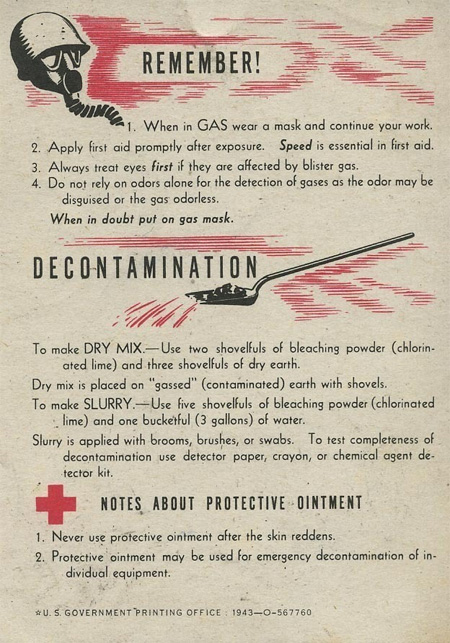
Illustration of a 1943 CWS pamphlet (covering gas attack and decontamination) circulated during training sessions held at LaGarde General Hospital.
Each group took its turn in erecting or tearing down camp, packing, hauling supplies, furnishing details – it was an adequate system, because it was fair, and the efficient teams worked well together. The first evening in camp, all troops took a night road march with simulated gas and air raid attacks. The second night a forced hike in conjunction with an evacuation problem was undertaken. Another night, a combined road march and motor movement was accomplished. The central feature of the bivouac came on the night of 09-10 February 1944. Under the direction of the Training Section a night move was accomplished, the whole camp, consisting of every item brought in and established, was taken down, packed, and transported a distance of six miles to the Slidell Firing Range. Having moved everything in total darkness and quietness, troops set up a representative hospital site at the new location and went to bed, exhausted. They were roused for reveille and breakfast and an immediate move back to the original site was made within ten hours, most of it still in total darkness (important to learn blackout operations). During that time, 2 camps had been dismantled and re-established, one meal had been prepared and eaten, and almost all personnel had slept a minimum of four hours. By 1000, 10 February, the original camp site had been renovated and routine camp duties re-established! The return trip across the lake was exciting but not too dangerous, it took three hours, and only 1 man got seasick. 12 February 1944, was a day of reckoning with inspections, athletics, and a full program on the post. Sunday morning, 13 February 1944, the bivouac came to an official close with church services.
Almost from activation day, the Hospital had made plans for overseas movement. Colonel Charles L. Kirkpatrick, MC, O-18642, Commanding Officer, had made the primary mission of the unit known to all personnel. As first months passed by, training in basic subjects had received first attention, but “POM” was constantly mentioned at Officers’ meetings. Pamphlets from the WD were carried around and studied. Beginning in fall of 1943, regular sessions by MAC Officers concerned in movements were called. There was a week in October, when daily sessions were held with the CO.
Although it was the unit’s responsibility to fill its own ranks, considerable difficulty and concern was felt about Officer and EM replacements. Re-organization of the Hospital according to T/O 8-550T (amended and tentative issue based on T/O 8-550 dated 1 April 1942 –ed) had brought to it a colored complementary unit and had brought Enlisted ranks almost to sufficient strength numerically. Through various Training Schools, most men had been well prepared for specific assignments and had already received their MOS numbers. Some men however, such as buglers, barbers, optometrists, and certain specialties, were particularly difficult to allocate. Therefore Major David I. Rutledge conducted a thorough physical of all troops; some were subsequently weeded out, and replacements and fillers were then provided by Eighth Service Command and LaGarde General Hospital.
In January 1944, Eighth Service Command named the Nurses who were to join, while the War Department selected the required Officers.
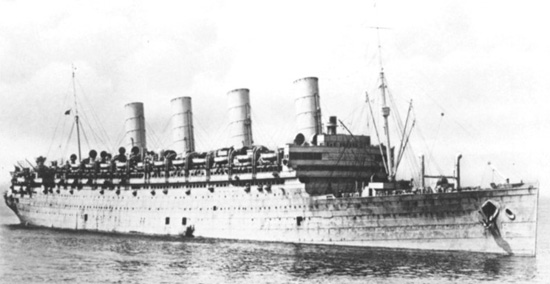
Illustration of RMS “Aquitania”, the British troopship that carried the Advance Party of the 182d General Hospital overseas, and many other military personnel during its war service.
Nurses Complement:
ANC Officers
1st Lieutenant Estella M. Guilliams (from Harmon General Hospital, Texas)
2d Lieutenant Marjorie O. Stewart (from Letterman General Hospital, California)
1st Lieutenant Jeanette Munroe (from Camp Carson, Colorado)
2d Lieutenants Doris M. Robin + Amelia D. Pretka + Alice E. Colvin + Lucille K. Daggett + Ruth C. Greeley + Marjorie Kirkpatrick + Alice W. Menoher + Pearl L. Miles + Edna A. Kroeker + Isabel S. Paulson + Frances J. Spillman (all from Camp Claiborne, Louisiana)
2d Lieutenants Vivian E. Crouch + Florence Rose + Victoria D’Anna + Ethel P. Horton + Edna A. Kroeker + Elsie M. Lee + Elva L. Long + Ruth M. Petrie + Margaret R. Setzer (all from Camp Barkeley, Texas)
2d Lieutenants Elah M. Pullen + Donna D. Bromerski + Elizabeth L. Fleming + Martie R. Ress + Sara L. Werstler (all from Camp Hood, Texas)
2d Lieutenants Bernice M. Basore + Violet D. Segar + Mary C. Baltz + Frances S. Bruehl + Julia E. Koszalka + Rubye L. Miller + Helen C. Scarborough + Eleanor G. Tabscott + Eunice E. Watts (all from Brooke General Hospital, Texas)
2d Lieutenants Madeline R. Dickson + Grace Dosher + Louise G. Erman + Annabelle Fritts + Ruth I. Moorman + Irene E. Owens + Zella F. Syms + Ruth K. Horton + Sidonia M. Burns (all from Fort Sill, Oklahoma)
1st Lieutenant Eleanor S. Devlin (from LaGarde General Hospital, Louisiana)
2d Lieutenants Mary A. Fiumano + Marian R. Slavin + Helen D. Pai + Marjorie E. White (all from Borden General Hospital, Oklahoma)
1st Lieutenant Isabel White + 2d Lieutenants Mahaley A. Davis + Hazel Denmon + Allene M. Ford + Ernestine Land + Adelene McDowell + Irene Pickett + Louise Rachal + Helen I. Ross + Anna K. Scott + Alma L. Wagner (all from Camp Polk, Louisiana)
2d Lieutenants Lillian L. Koerth + Eunice D. Murray + Eleanor D. Moore + Claire D. Wagner + Estella L. Wright (all from William Beaumont General Hospital, Texas)
1st Lieutenant Thelma L. Ferguson + 2d Lieutenants Julia G. Hydrick + Lina V. Lundquist + Marjorie Matheson + Yvonne L. Robideaux (all from Fort Bliss, Texas)
2d Lieutenants Marian R. Archer + Mildred H. Gustafson + Louise T. Kern + Susie K. Manion + Clyde M. Sanders (all from Camp Howze, Texas)
2d Lieutenants Mary K. Gaffney + Elizabeth C. Hechler + Florence O. Zimmerman + Eleanor V. Van Sant (all from Camp Wallace, Texas)
2d Lieutenants Valita Doring + Evelyn Rothacker + Helen M. Bradbury + Elsa J. Dodge (all from Camp Gruber, Oklahoma)
2d Lieutenants Jane Kirschner + Irene Tzupp + Nora Roso + Vera R. Wojnar + Marcella M. Kelly (all from Camp Maxey, Texas)
2d Lieutenants Josephine Checknite + Helen T. Devine + Virginia O. Diggdon + Marguerite L. Johnene + Myrtle Kelly + Emily U. Russell + Eleanor L. Shaw (all from Indiantown Gap Military Reservation, Pennsylvania)
2d Lieutenant Beatrice F. Goldstein (from Camp Van Dorn, Mississippi)
2d Lieutenant Marthaross Kauffmann (from Camp McCain, Mississippi)
1st Lieutenant Ruth J. Hefner + 2d Lieutenant Anna L. Siegfried (all from Camp Breckinridge, Kentucky)
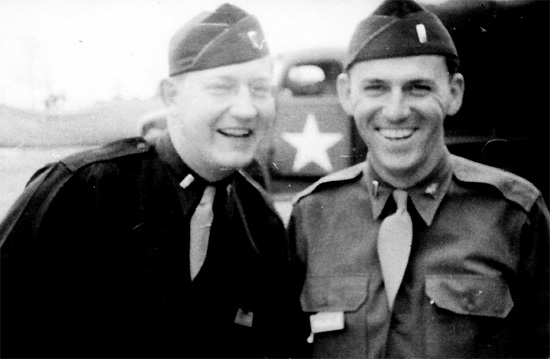
Photo of 1st Lieutenants Melvin D. Gulley and Paul D. Hass, taken during spring of 1944 in England. Courtesy of Chris Clippinger.
The grand total of Nurses was too high (116), and Eighth Service Command reduced this number upon information from the War Department that all General Hospitals’ Nurse T/O would be reduced from 100 to 83. For this reason and including some physical disabilities, 28 Nurses were dropped from the current roster.
A number of Officers arrived during the period 1 January – 15 March1944, and 38 additional Medical and Medical Administrative Corps Officers were assigned to duties or transferred to the 182d General.
Officers Complement:
Major Andrew G. Solla (ChC, from Port of Embarkation, New York, assigned Chief of Chaplains)
1st Lt. Richard L. Geiger (MAC, from Harmon General Hospital, Georgia, assigned Chief, Prosthetic Section, Dental Service)
Captain William J. Deragisch (MAC, from Camp Barkeley, Texas, eventually transferred to Brooke General Hospital, Texas)
1st Lieutenant Wesley J. Dudziszewski (MAC, from Camp Barkeley, Texas, eventually transferred to Camp Hood, Texas)
Captain Donald F. Purvis (MC, from Lincoln Field, Nebraska, assigned Ward Surgeon, Communicable Disease Section, Medical Service)
1st Lieutenant Richard H. Stahl (MC, from Rapid City Army Air Base, South Dakota, assigned Assistant Chief, EENT Section, Surgical Service)
Captain John J. Brophy (MAC, from MRTC Camp Barkeley, Texas, eventually transferred to Brooke General Hospital, Texas)
Captain Cleo R. Gatley (MC, from Pyote Army Air Field, Texas, assigned Ward Surgeon, Cardio-Vascular Section, Medical Service)
Major Louis S. Deitchman (MC, from Sheppard Field, Texas, assigned Chief, EENT Section, Surgical Service)
Lieutenant Colonel Victor Baer (MC, from Orlando Air Base, Florida, eventually transferred to Brooke General Hospital, Texas)
Lieutenant Colonel Henry I. Riedel (MC, from Chico Army Air Field, California, transferred to LaGarde General Hospital, Louisiana)
Major Bernhardt J. Statman (MC, from Amarillo Army Air Field, Texas, assigned Chief, General Medicine Section, Medical Service)
Captain Lawrence Adler (MC, from Laughlin Field, Texas, eventually transferred to Glennan General Hospital, Oklahoma)
Captain Howard G. Bateman (MC, from Big Springs Army Air Field, Texas, assigned Ward Surgeon, Neuro-Psychiatric Section, Medical Service)
Captain Ralph L. Best (MC, from Big Springs Army Air Field, Texas, assigned Ward Surgeon, Respiratory Section, Medical Service)
Captain Harry A. Brotman (MC, from Selman Field, Louisiana, eventually transferred to 35th General Hospital, Oklahoma)
Captain Oliver R. Buesing (MC, from Army Air Forces Classification Center, Tennessee, assigned Ward Surgeon, Orthopedic Section, Surgical Service)
Captain Harold I. Ginsberg (MC, from Sheppard Field, Texas, assigned Ward Surgeon, General Medicine, Medical Service)
Captain Keith F. Krausnick (MC, from Altus Army Air Field, Oklahoma, assigned Assistant Chief, Roentgenological Service)
Captain Thomas B. Matlock (MC, from Lake Charles Army Air Field, Louisiana, assigned Chief, Officers’ Section, Medical Service)
Captain Richard C. Miller (MC, from Drew Field, Florida, eventually transferred to LaGarde General Hospital, Louisiana)
Captain Melvin D. Mills (MC, from Drew Field, Florida, assigned Ward Surgeon, Gastro-Intestinal Section, Medical Service)
Captain Daniel F. H. Murphy (MC, from Wendover Field, Utah, assigned Chief, Communicable Disease Section, Medical service)
Captain Euston S. Robertson (MC, from DeRidder Army Air Base, Louisiana, assigned Chief, Officers’ Section, Surgical Service)
Captain Herbert H. Schneider (MC, from Santa Maria Army Air Field, California, assigned Chief, Anesthesic Section, Surgical Service)
Captain Robert T. Anderson (MC, from Westover Field, Massachusetts, eventually transferred to LaGarde General Hospital, Louisiana)
Captain Harry W. Fishler (MC, from IV Fighter Command, California, eventually transferred to Brooke General Hospital, Texas)
Captain Paul J. Barlow (MAC, from 100th General Hospital, Tilton General Hospital, Fort Dix, New Jersey, eventually transferred to Camp Hood Station Hospital, Texas)
Major Leonard Wallach (MAC, from Headquarters Army Ground Forces, Army War College, Washington DC, eventually transferred to Camp Hood Station Hospital, Texas)
1st Lieutenant Robert W. Laurrell (MAC, from 682d General Hospital Complementary Unit, assigned Commanding Officer, Detachment of Patients)
Captain Colin F. Vorder Bruegge (MC, from Camp Bowie, Texas, assigned Chief, Laboratory Service)
Mr. Burton H. Seigel, WOJG (USA, from Headquarters Eighth Service Command, Texas, assigned Assistant Personnel Officer)
Captain William B. Patton (MC, from LaGarde General Hospital, Louisiana, assigned Chief, Neuro-Surgical Section, Surgical Service)
1st Lieutenant William J. Holloway (ChC, from Fort Sill, Oklahoma, assigned Assistant Chaplain)
Major Lowell E. McKelvey (DC, from Army War College, Washington DC, assigned Chief, Dental Service)
1st Lieutenant Carl E. Cummins (MAC, from 682d General Hospital Complementary Unit, assigned Registrar)
1st Lieutenant Edward J. Komora (MC, from LaGarde General Hospital, Louisiana, assigned Ward Surgeon, Septic Surgery Section, Surgical service)

Illustration of British transport “Athlone Castle” which carried the bulk of the 182d General Hospital overseas. She departed New York Port of Embarkation as part of a large convoy on 29 March 1944 with destination the United Kingdom.
Those Officers lost among the staff were transferred to Camp Claiborne Station Hospital, Louisiana and/or to the 94th General Hospital, Camp Barkeley, Texas.
On 14 March 1944 (last day spent at LaGarde General Hospital –ed), the Officer staff stood at 54 Officers, 1 Warrant Officer Junior Grade, 83 Nurses, 2 Physical Therapists, and 3 Hospital Dietitians, or a total of 143 Officers assigned to the Hospital unit. Enlisted strength of the 182d General Hospital was 324, while that of the 682d General Hospital Complementary Unit numbered 3 Officers and 191 EM.
Preparation for Overseas Movement:
Movement of the 182d General Hospital overseas was accomplished in a number of waves. The troops were transported to Camp Kilmer, Stelton, New Jersey (Staging Area for New York Port of Embarkation, total acreage 1,815, troop capacity 2,074 Officers and 35,386 Enlisted Men –ed).
First Wave – on 3 March 1944, the advance party went to Fort Hamilton, New York, accompanied by Major William A. Cooper (CO), 1st Lt. Joseph R. Devine, S/Sgt Leonard Harwood, S/Sgt Lester McCue, and S/Sgt Francis L. Wamsley. Embarking on 22 March, the group departed aboard RMS “Aquitania” for Liverpool, England, and thence moved over land to Llandudno, North Wales. They were re-united with the unit on 5 April 1944.
Second Wave – on 10 March 1944, a group consisting of 88 female Officers (ANC), under command of 1st Lieutenant John K. Lattimer, left for Cp. Kilmer, New Jersey, where they were joined by the main body of personnel.
Third Wave – on 15 March 1944, the main body moved from LaGarde General Hospital by train, under command of Lieutenant Colonel Dale C. McCarty, 1st Lt. Paul D. Hass; Transportation Officer, 1st Lt. Edward D. McKenna; Troop Commander; and Capt. John S. Kapernick; Train Surgeon.
The 682d General Hospital Complementary Unit also moved out the same day, with Major Lodwick S. Meriwether as Train Commander; 1st Lt. John V. Richardson, Sr.; Transportation Officer; and 1st Lt. Daniel A. Glomset; as Train Surgeon. They arrived at Camp Kilmer on 17 March, and after arrival, all three Officers were returned to the 182d GH.
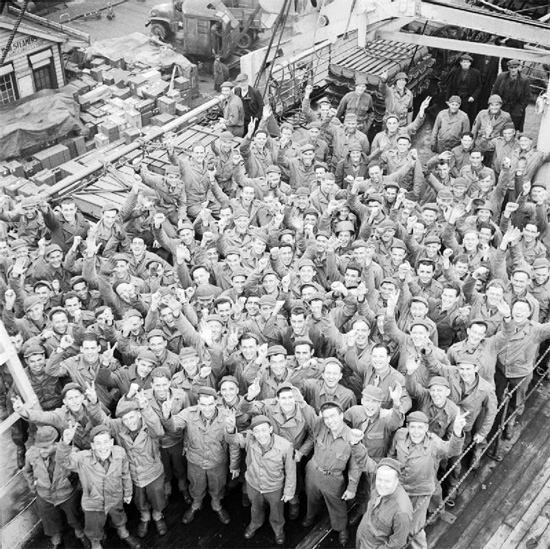
GIs aboard the “Athlone Castle” cheer and give the V-for-Victory sign on arrival at Liverpool 5 April 1944.
Camp Kilmer was one continuous round of activity. The unit was processed in rapid fire, thorough style. Certain courses of instruction concerning the new gas mask, water safety and personal affairs were completed. Packing and storing for overseas movement occupied considerable time, as did issuance of special equipment, all records were reviewed and completed, and every individual received a partial pay. The first move to the port area came with stowing of bulk supplies and records on 20 March. On 21 March, 15 Officers went to the New York Port of Embarkation, Brooklyn, to act as Loading Officers. On the following day, all troops left Camp Kilmer to embark (the 682d unit had been separated from the 182d GH by this time and was to be shipped separately in the convoy but on the same date). The 182d General Hospital embarked on HMT “Athlone Castle” (requisitioned as troopship 27 December 1942 –ed) at1400 hrs, 28 March 1944,and sailed the following morning, 29 March 1944 for the United Kingdom.
United Kingdom:
From 29 March 1944 – 5 April 1944, the 182d General Hospital was at sea. The “Athlone Castle” was one of 28 vessels in the convoy. Life was difficult and yet pleasant under extremely crowded conditions. It was fortunate that the weather was good as most of the journey the troops could stretch on the decks. A very limited training program was conducted and exercises were taken daily along with regular boat drills.
The first taste of life in the ETO was experienced in Liverpool, Lancashire, England, on 5 April 1944. Having arrived at the mouth of the Mersey River late 4 April, the ship was however delayed until high tide. Warily tugs and buoys led the way through intense fog into Princess Landing Stage on the morning of 5 April. While troops readied themselves for debarkation, Officers were assembled to receive their orders. Landing schedules were reviewed and SOPs studied under guidance of the Port Authorities. Colonel Harold R. Duffie, Port Commander, came aboard to welcome the troops to England, while a British Officer accompanied him to represent H. M. The King.

Partial view of the layout illustrating Area I + II of the 182d General Hospital, while stationed at Sudbury, Derbyshire, England.
It was at this meeting, that the 182d heard the news that it was destined for Llandudno, Caernarvonshire, North Wales. It was also learned that the 682d General Hospital Complementary Unit had shipped in the same convoy (though on a different ship) and was ordered temporarily to Camp Huyton, Lancashire.
The organization debarked at 1600 hrs, going directly to the train from the landing stage. The rail convoy proceeded via Chester to Llandudno, where it arrived at 2200 hours. It was met on site by the advance party who took over billeting of the troops. Lieutenant Colonel W. A. Priebe, Executive Officer for the Provisional Staging Area; and 1st Lieutenant Mabel Gardner, Director of Nurse Training; were present to welcome the group and assist. The Hospital set up a Headquarters on the fourth floor of the “Claremont Hotel”. Being billeted in private homes around Llandudno was truly a new experience for the unit. Some homes were more comfortable than others, but conditions were generally alike in that everyone ate at the Army Messes, one of which was operated by personnel of the 182d General, and that all participated in the same training programs. Programs in progress included those for Enlisted personnel, Officers, and Nurses (who often trained with Nurse groups of other hospitals in the community). An achievement day was celebrated at the end of the courses, in presence of high brass and dignitaries, such as: Colonel Fenton S. Jacobs (CO > Western Base Section), Colonel Mack Green (Western Base Section Surgeon), and Colonel D. J. Berry (Acting CO > Llandudno Provisional Training Area). Captain John K. Lattimer was in charge of the event and was favorably mentioned in a number of commendatory letters, with wide publicity in both the British and US press.
One of the duties performed by the 182d Gen Hosp while stationed at Llandudno was the operation of “The Willows”, a Dispensary for quarters patients. This unit was used because hospitalization was inconvenient for minor illnesses in that patients had to be transported so far to the 83d General Hospital at Ellesmere otherwise. Major Meriwether and Captain Larson staffed the Dispensary through use of rosters so that most all professional people had an opportunity to work there. In addition to this, the unit maintained its Dispensary for daily sick call at No. 5 Mostyn Street, Llandudno.
A special feature of training was encountered for Officers and certain Enlisted Men; Detached Service for the purpose of inspecting operational units and learning of them. Among installations visited were the 1st General Hospital, 1st Medical General Laboratory, 19th General Hospital, 83d General Hospital, 108th General Hospital, 168th Station Hospital, and 312th Station Hospital. Some Officers were detailed for Special Duty to the 10th Replacement Depot, the 316th Station Hospital, and to the XVIII and XIX Districts for assignments to Temporary Duties in anticipation of expected D-Day activities.
On 8 May 1944, the Hospital was alerted for movement to a permanent location for operational activity. Movement Order No. 969, Western Base Section, Communication Zone, ETOUSA, dated 4 May 1944, named Hospital Plant # 4187 at Sudbury, Derbyshire, England.
At the time, the site was occupied by the 108th General Hospital, and about one half of the professional staff, and all key men in the Administrative Sections, both Officers and EM, proceeded to Sudbury on 10 May for a period of 7 days of DS to observe operational functions and procedures of the 108th preparatory to taking over on 16 May. 28 Officers, 30 Nurses, and 240 EM were involved in this movement. Simultaneously, the 108th General Hospital moved out as many as was feasible to make room for the 182d’s coming. By the end of the 7-day period, almost all jobs were assumed by 182d personnel, and the remaining members of the units were exchanged on 16 May. On 17 May, the 682d General Hospital Complementary Unit arrived for duty to complete the entire movement to the new location. The organization’s first year of operation found the plant with an initial capacity of 1,034 beds, with a possible tent expansion unit of 284 extra beds erected with semi-permanent wooden flooring. Expansion of messes and latrine facilities were later accomplished to cover the expansion.
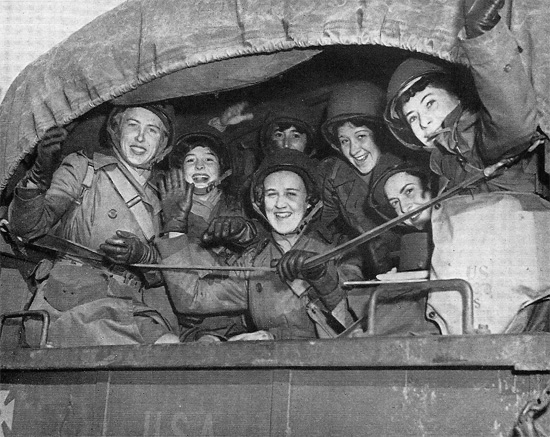
ANC Officers of the 182d General Hospital traveling in England. When on Detached Service, depending on distance involved and available transportation, movement took place by rail or by motor convoy.
Location assessment: arriving there, the 182d General Hospital found a post of 44½ acres on land gently sloping toward the Dove River, western boundary of Derbyshire. Sudbury, was an old English village only a half mile down the road toward Derby which was 10 miles east of the camp. Long wooded slopes, rolling hills of considerable height, and other picturesque towns and villages, such as the town of Uttoxeter, presented lovely vistas. The land was a deer park property that had been acquired from Lord Vernon. Climatic conditions were rather severe, due to the cold and damp most of the time, causing problems to people with chronic sinus and respiratory trouble. Rainfall was high during summer, fall, and winter.
On the post were 126 buildings, including 29 wards. Originally built to house a 750-bed Station Hospital, the wards, the administrative buildings, and mess halls, were constructed of bricks with asbestos roofs and concrete or iron trusses. Officers’, Nurses’, and Enlisted Men’s quarters and many administrative offices were in Nissen huts with curved asbestos roofs and concrete floors. Heating problems caused by the great number of small units was only partially solved with help of British slow-combustion stoves operating with coke. Such stoves were replaced as fast as possible by American QMC stoves, and at year’s end they were found in all wards, tents, and central offices – quarters for Officers and EM however still contained British-type stoves!
Hot water was provided from a central boiler, while steam for sterilization in surgery and for dishwashing came from a 10-horsepower upright steam boiler (operated by civilian employees under Area British Royal Engineers). Roads on the post were of concrete construction and sidewalks were covered, except for their sides.
The biggest job awaiting the unit was the bed expansion program which took from 16 to 30 May 1944 to complete, this allowed an increase of bed space from 750 to 1,034. In November and December, the tents were winterized and wooden half-walls and doorways were erected. The patients’ mess hall was expanded and 2 additional coal ranges were installed along with an extra dishwashing machine. All cook houses were repainted.
Shortly after arrival, a public address system was built, all wards received speakers, and with 2 extra outdoor speakers, the entire Hospital was covered. Also the Officers’ Club and Mess were covered (it allowed for distribution of special announcements, entertainment programs, and AFN).
The water supply came from the nearby Dove River, and the available pump station also supplied G-18. Sewage disposal was provided by a sewage disposal plant.
Maintenance of all installations in the United Kingdom was the duty of the (British) Royal Engineers. A garrison Engineer was assigned each post along with a clerk of works and sufficient civilian labor. But in this case, the number of local employees was far from adequate, and the Hospital T/O which only provided for a single Utilities Officer and 7 EM proved totally inadequate. The total of 15 men was not sufficient to keep the work up-to-date at all times – it was therefore recommended that in future T/Os would provide for men with trade skills and engineer basic training, such as electricians – plumbers – and carpenters. In some instances the fortunate use of German PW labor helped considerably with the upkeep of the grounds.
The purpose of the 182d General Hospital was to provide general hospital care for patients evacuated from the front and certain Station Hospitals in its vicinity. In addition to acting as a General Hospital it also served as a Station Hospital for a large number of US troops in the area.
Detachment A, 182d General Hospital, meanwhile officially opened for receipt of patients on 28 April 1945 at Lichfield, Staffordshire, England, where it operated a 215-bed Hospital Plant, at APO 874, formerly under control of the 348th Station Hospital.
The 182d General Hospital actually began functioning as a true hospital on 16 May 1944 in Sudbury, Derbyshire, England, taking over operations from the 108th General Hospital.
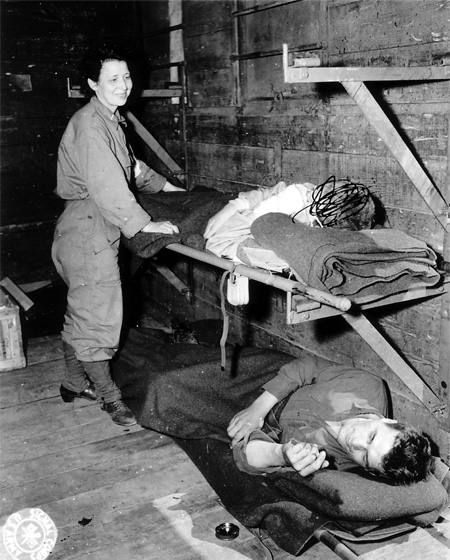
Inside view of a ward car in a Hospital Train (picture taken near the Lison railhead, France). Some arrangements and modifications of the basic cars were sometimes necessary when converting standard rolling stock for transportation of patients (often the case overseas).
Operation:
The Admission & Disposition Office occupied a building which was located at the front and center of the installation! Every patient entering the Hospital (except battle casualties who passed through the recreation building located 50 yards east of this facility) came through this building.
The majority of patients admitted came from the following camps and units for whom the 182d General acted as Station Hospital:
10th Replacement Depot
AAF Station 594
G-18 General Depot
G-20 General Depot
ETO PWE #2
ETO PWE #4
ETO PWE #6
ETO PWE #7
82d Airborne Division
87th Infantry Division
95th Engineer General Service Regiment
360h Engineer General Service Regiment
390th Engineer General Service Regiment
16 different Antiaircraft Artillery Battalions
Besides acting as a station hospital for above named units, the group acted as a General Hospital for the following Station Hospitals:
33d Station Hospital
228th Station Hospital
305th Station Hospital
307th Station Hospital
312th Station Hospital
The 182d General Hospital was also made the Prison Hospital for ALL United States Army Prisoners in the Western Base Section, per Letter, 7 June 1944 (also included were German PWs who were cared for during 4 months).
All patients treated by the unit were either received by ambulance or Hospital Train. The patients who came by ambulance were from nearby camps or hospitals (those who had to drive less than 40 miles). Only a single convoy of patients arrived by ambulance from the 184th General Hospital.
Seven (7) Hospital Trains arrived into the hospital area between 15 May and 10 November 1944. These trains unloaded at G-18, located about 2 ½ miles from the unit. The first Hospital Train that came in was from the 67th General Hospital, while the next 6 were loaded with battle casualties. Trains averaged 290 patients, 225 litter patients, and 65 ambulatory patients. Time between arrival of train and admission of last patient to ward was never over 120 minutes! In the above period, 5,700 patients were admitted, of which 1,210 were battle casualties.

Illustration showing members of the unit’s motor pool staff. Photo taken stateside in 1941.
On discharge all patients passed through the Admission and Disposition Office, while transportation was being arranged from the hospital by ambulance, by train, or by airplane. Patients being returned by boat to the ZI were sent to a Holding Hospital, Air Evacuation-bound patients were sent to an airfield three miles from the unit’s location. It should be noted that the largest of any one clinical group of patients were orthopedic battle casualties, but there were also a large number of neuro-psychiatric cases. The majority of patients admitted to the 182d were the type in which General Hospital care or final disposition was indicated.
Following V-E Day, a number of changes in personnel occurred. Approximately 50 EM were transferred to Replacement Depots; they were retained in the “Reconversion of Infantry Training” program (lack of basic infantry replacements –ed). Consequently as per Paragraph 6a, Circular # 69, Headquarters, ETOUSA, dated 13 June 1944, a first group of 10 EM were transferred from the Detachment of Patients to the 10th Replacement Depot on 25 June 1944. More losses in personnel were suffered with transfer of another 5 Enlisted Men to the same Depot, APO 874, in September 1944. A group of another 32 Enlisted Men were separated from the unit to operate a small hospital at the 10th Replacement Depot. They came from different departments and sections to form an efficiently operating unit. Eleven (11) Enlisted Men left the organization in February 1945. During 1945, the 682d General Hospital Complementary Unit, attached to the 182d General Hospital, continued carrying out its primary function, that of furnishing cooks, bakers, truck drivers, utility personnel, and basic services for the operation of a General Hospital.
Reports were submitted as per Section I, Circular No. 58, European Theater of Operations, to Chief Surgeon, USFET, APO 887 and to Surgeon, United Kingdom Base, APO 413, Unites States Army.
United Kingdom Stations – 182d General Hospital
Llandudno, Caernarvonshire – 6 April 1944 > 8 May 1944 (operated “The Willows” Dispensary)
Sudbury, Derbyshire – 16 May 1944 > 16 June 1945
Lichfield, Staffordshire – 28 April 1945 > 22 June 1945 (Detachment A, 215-bed capacity)
Organization & Statistics:
Command 182d General Hospital, US Army – evolution of command assignment of Officers (1944-1945) incomplete:
Colonel Charles L. Kirkpatrick, MC, O-18642, Commanding Officer (reld 27 Jun 45 + trfd to 188th General Hospital 5 Jul 45)
Colonel Milton I. Strahl, MC, O-209938, Actg. Commanding Officer; Commanding Officer (asgd 5 Jul 45 from 306th Station Hospital + asgd 4 Sep 45 to 52d General Hospital)
Lt. Colonel Clarence F. Albers, DC, O-140774, Commanding Officer (asgd 3 Nov 45 from 185th General Hospital)
Lt. Colonel Jacob Brem, MC, O-285742, Executive Officer
Lt. Colonel Gordon C. MacRae, MC, O-289117, Commanding Officer (21 Sep 45)
Lt. Colonel Dale C. McCarthy, MC, O-311714, Hospital Inspector; Executive Officer; Actg. Commanding Officer (27 Jun 45); Commanding Officer (28 Jun 45); on TD to 168th Station Hospital 1 Jul 45)
Major Sidney B. Rosenbluth, MC, O-436405
Major Henry Swan, MC, O-515869, Post Surgeon; Summary Court Officer
Captain Ellison E. Alden, MC, O-1691130
Captain Wilbur E. Arnold, MAC, O-405717, Postal Officer
Captain William F. Blanks, MAC, O-1547236, Unit Personnel Officer; Adjutant
Captain Lake S. Gill, MAC, O-1544020, Class “A” Agent Finance Officer; Supply Officer; Transportation Officer
Captain Paul D. Hass, QMC, O-1588035, Unit Supply Officer; Unit Claims Officer; Transportation Officer; also Supply Officer 687th General Complementary Unit (1 Sep 45) and Supply Officer 327th Station Hospital (31 Nov 45)
Captain William V. Herrin, MAC, Adjutant
Captain Malcolm B. Melroy, SnC, O-490365, Asst. Chief Laboratory Service; Post Exchange Officer
Captain Alvin E. Reynolds, MAC, O-1545563, Safety Officer
Captain John V. Richardson, Sr., CE, O-1588250, Unit Gas Officer; Unit Engineer; Actg. Commanding Officer & Actg. CO 682d General Hospital Complementary Unit (28 Aug 45)
Captain Arthur D. Rosenthal, MC, O-346161
Captain James O. Sloss, MC, O-388174, Surgical Ward Officer
1st Lieutenant Irving Rosefield, SnC, O-490436, Asst. Laboratory Officer; Asst. Provost Marshal
Medical Service – professional services were divided into eight different sections with the following Officers:
| Chief of Medicine | Lt. Colonel Lodwick S. Meriwether |
| Chief of Cardio-Vascular Section & Assistant Chief of Medicine | Major David I. Rutledge |
| Chief of General Medicine Section | Major Thomas B. Matlock |
| Chief of Gastro-Intestinal Section | Captain Daniel A. Glomset |
| Chief of Neuro-Psychiatry Section | Captain Arthur D. Rosenthal |
| Chief of Contagious Disease Section | Major Daniel Murphy |
| Chief of Dermatology Section | Captain Donald Purvis |
| Chief of Respiratory Disease Section | Major Berhnardt J. Statman |
| Ward Officer | Captain Cleo Gatley |
| Ward Officer | Captain John Godfrey |
| Ward Officer | Captain Melvin D. Mills |
| Ward Officer | Captain James O. Sloss |
Sixteen (16) wards and 5 tents were assigned to the Medical Service with a combined bed capacity of 559. All wards were open ones, with the exception of three, two of which had bars on windows, and one which was set up within a stockade. Fourteen (14) of the wards had bed capacities varying from 30 to 34, one (1) had a capacity of 18 beds, and another one (1) had only 2 beds. The 5 tents came with a bed capacity between 13 to 15 beds. The ward located within the stockade was used for enemy PWs, while one of the large wards with barred windows was used for patients, prisoners of own forces, and the remaining one was for patients requiring solitary confinement. The organization included following services: Office of the Chief of Medical Service, General Medical Section, Cardio-Vascular Section, Gastro-Intestinal Section, Communicable Disease Section, Respiratory Section, Neuro-Psychiatry Section, Venereal Disease Section, Dermatological Section, and Outpatient Department.

Left: Second Lieutenant Paul D. Hass (QMC).
Right: Second Lieutenant John V. Richardson, Sr. (CE). Photo taken stateside in 1943.
At first the Medical Service staff consisted of 4 Majors and 8 Captains, changes and promotions brought it to 1 Lt. Colonel, 4 Majors, and 7 Captains. The number of Nurses and Enlisted Men, though of excellent quality, was sometimes inadequate, certainly at times when large numbers of patients were being admitted. In total 2,975 cases were admitted to the Medical Service, and at the end of the active period 433 remained. Since the 182d started its operations (16 May 1944), 7,238 medical treatments were accomplished (including US Army personnel, British Army personnel, and civilian cases).
When the Hospital was swamped with patients who had suffered cold injury to the feet in January and February 1945, the cases were so numerous, that treatment was standardized as much as possible after consulting the medical and the cardio-vascular staff. At the time a great deal of confusion was caused by the lack of clarity as to what was to be called “Trench Foot” and what condition was to be designated “Frost Bite”. This came about because an Army Directive stated that patients with frost bite would receive the Purple Heart while those suffering from trench foot would not (finally the award was made on the basis of the diagnosis of the first Medical Officer who saw the patient, causing some unfairness –ed). It was learned later that adequate foot hygiene under combat conditions and improved footwear were precautions to prevent a certain amount of cold injury.
As Allied Armies advanced further east, German Prison Camps were overrun and a large number of RAMPS were admitted to the 182d General. Their cases were very interesting and introduced a number of problems most medical personnel were not familiar with.
Daily operational activities were subdivided as follows: starting with reveille at 0645 hours; breakfast from 0700 to 0800 hours; dinner from 1130 to 1230 hours, and supper from 1700 to 1800 hours. Retreat was held each day at 1700 hours. Ward assignments started at 0700, others at 0800. Night duty started at 1900 hours.
Surgical Service – professional assignments were as follows:
| Chief of Surgery | Major William A. Cooper |
| Chief of General Surgery Assistant Chief of Surgery |
Major Rochfort W. Kearney Major Stephen C. Meigher |
| Chief of Orthopedic Surgery | Major Reed S. Clegg |
| Chief of Officers Surgery | Major Edward M. Lipan |
| Chief of Septic Surgery | Captain Stephen C. Meigher |
| Chief of Urological Surgery | Major Gordon W. Strom |
| Chief of EENT Surgery | Major Louis S. Deitchman Captain Nathan Regal |
| Chief of Anesthesiology & Operating Room | Captain Herbert H. Schneider |
| Neurosurgeon | Captain William B. Patton Captain Nathan Regal |
| Ward Officer | Captain Oliver R. Beusing |
| Ward Officer | Captain Roderick M. Neale |
| Ward Officer | Captain Edward J. Komora |
| Ward Officer | Captain John K. Lattimer |
| Ward Officer | Captain Euston S. Robertson |
| Ward Officer | Captain Richard M. Stahl |
| Ward Officer | Captain Robert N. Foley |
| Ward Officer | Captain Joseph Marks |
| Ward Officer | Captain Hyman Morris |
Some changes were later made by higher authority, and a lone woman Physician was admitted, 1st Lieutenant Jean L. Dunham, ANC (who replaced Captain H. H. Schneider). A Captain Robert N. Foley eventually joined 15 September 1944 and was assigned to the Septic Section. Total Officer strength went up to 15 members. In total there were 14 wards of 30 beds each assigned to the Surgical Service. From 15 May to 1 October 1944 a total of 2,445 patients were treated in subject wards. A total of 886 were battle casualties, 467 remained in the service after 1 November 1944, and 1,978 were discharged. Only 1 death occurred in the same period. From the beginning of its operational activities, 6, 921 surgical treatments were dispensed (including US Army personnel, British Army personnel, and civilian cases). Between 1 November 1944 and 1 August 1945, 2,233 patients were treated by the Surgical Service.
The distribution of wards was carried out as follows: General Surgical Section – 2 wards, Septic Surgical Section – 2 wards, Orthopedic Surgical Section – 3 wards, Urological Surgical Section – 2 wards, EENT Surgical Section – 1 ward, Officers – 1 ward, Unassigned Patients – 3 wards.

First Lieutenant John V. Richardson, Sr. on cleaning duty at the Hospital. Photograph taken during the unit’s time in England, 1944.
Courtesy of John V. Richardson Jr.
Army Nurse Corps – the Nursing personnel consisted of 83 Nurses, with 1 Captain, 8 First Lieutenants, and 74 Second Lieutenants. In total 28 wards were available, and assignment of personnel was arranged as follows: 1 Principal Chief Nurse, 1 Assistant Chief Nurse, 1 supervisor of Medical Section, 1 supervisor of Surgical Section, 1 Night supervisor, 1 Operating Room supervisor, 3 Nurse Anesthetists, 6 Operating Room Nurses, 2 Nurses for Central Supply, 1 Nurse in the EENT Section, 1 Nurse in the Dental Clinic, 6 relief Nurses, 10 Nurses on Night duty, and the remainder of the Nurses spread over the Medical Service, the Surgical Service, and the Orthopedic Section. Nurses were rotated on a regular basis to give them more experience. Normal duty was 8-hours per day, with 1 day off per week. With heavy patient load this could lengthen to 12 or 16 hours per day without time off, or only a single afternoon off duty per week.
American Red Cross – the Red Cross unit consisted of Mrs. Carol B. Moore; Assistant Field Director, Miss Ruth Davies; Recreation Worker, Miss Frances Hamacher; Recreation Worker, Miss Ruth Trenholme; Staff Aide, and Miss Marjorie Serrick; Secretary. They took over the ward recreation programs in the Rehabilitation Section, and provided comfort articles to battle casualties and needy patients. At the suggestion of the CO, they met each incoming convoy of patients with cigarettes and hot chocolate. The separate ARC building consisted of a game room, ping pong and pool tables, a craft shop, a library, and a lounge. Tours were equally arranged, including Sunday dinner invitations to English homes, and organization of movies or stage shows. The Assistant Field Director’s Office was always open for social services, loans, communications, and personal consultations. A “Clubmobile” unit stationed nearby brought coffee and donuts to patients and personnel once a week.
Chaplain’s Service – there were 2 Protestant Chaplains and 1 Catholic Chaplain. A Chapel was prepared with offices adequately furnished with the necessary seating for 200. Weekly services were conducted for the benefit of both patients and personnel, and each week Jewish patients and hospital personnel were furnished transportation into Derby for their own services. Chaplains were always present at the reception of convoys.
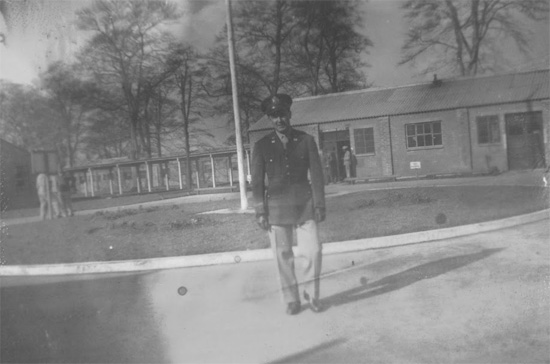
Captain John V. Richardson, Sr. stands in front of the flag pole at the 182d General Hospital. Photo probably taken in 1944.
Courtesy of John V. Richardson Jr.
Special Service – in April 1945, a soft ball team was organized composed of players from both the 182d General Hospital Detachment (11 people) and the 682d General Hospital Complementary Unit (8 people). The team had a very interesting and successful season playing 33 games and winning 28. During the months of April, May and June 1945, it participated in the G-18 League games, winning 14 and only losing one game to win the G-18 League Championship. On 6 June 1945, an exhibition game was played in Derby with the 184th General Hospital . The team later met the 825th Convalescent Center team, one of the outstanding teams in the UK, and won!
Education & Recreation – during 1944, the Special Service Officer, assisted by the American Red Cross, the Chaplains, and the Athletic Officer, was charged with recreation and morale of all Enlisted personnel of the unit. Day rooms were organized, nicely furnished, comfortable, and adequately stocked with reading material. There was a library, USO shows took place, and movies and dances were organized once monthly, either on the post or in nearby communities. The Training Officer even obtained 131 courses for hospital personnel at various British institutions, namely: Oxford University, St. Andrews University, Leeds University, Cambridge University, Stratford-on-Avon, and London …
During the period 1 January 1945 to 1 July 1945, plans and training continued in the command. Priority consisted in maintaining a high state of physical conditioning and discipline, together with continuation of advance technical training for Officers, Nurses, and Enlisted Men. An 8-hour training schedule each week was enforced for all. Formal retreat ceremonies were held three times a week. And twice a month, all personnel were required to participate in a 10-mile march with full field equipment. Gas alert, air raid alert, and fire drill were part of the weekly activities too. Group discussions based on problems outlined in “Army Talks” , were led by the I & E Officer. Leisure-time studies were provided by way of courses at the United States Armed Forces Institute, and short courses organized at several British Universities.

Somewhere in the ETO. Arrival of refrigerated blood in insulated containers. These were standard M-1941 insulated round hot food containers used without inserts, QMC Stock No. 74-C-1105.
Motor Transportation – a number of vehicles comprised the Motor Pool and were available during the first 6 months’ operation of the Hospital:
6 Ambulance, ¾-ton, 4 x 4
1 Trailer, ¼-ton, 2-wheel, Cargo
2 Trailer, 1-ton, 2-wheel, Cargo
2 Truck, ¼-ton, 4 x 4
3 Truck, ¾-ton, Command & Reconnaissance, 4 x 4
4 Truck, 1½-ton, Cargo & Personnel, 6 x 6
2 Truck , 2 ½-ton, Cargo, 6 x 6
1 Truck, 2 ½-ton, Dump, 6 x 6
1 Car, 5-Passenger, British (1 extra car delivered in 1945)
1 Bus, 30-Passenger, British (1 extra bus delivered in 1945)
2 Truck, British, Cargo or Dump (2 extra trucks delivered in 1945)
Almost immediately upon arrival in the United Kingdom, 60% of all T/O vehicles were released and picked up from the Ordnance Depots. Drivers were all from the 682d General Hospital Complementary Unit. Transportation was used for all supplies to the post, and for transfer of personnel and baggage to the railhead. The 682d also furnished cooks, bakers, utility sections and basics for the daily operation of the 182d General Hospital.
British Support & Assistance – the assistance from the British (Reverse Lend-Lease arrangements –ed) was adequate under the existing system. The British took charge of and ran some of the organizations dealing with salvage (operated by the local British Rural District Council); fire protection (in addition to the Post Fire Department, the British provided extra help via the National Fire Service of England); laundry (contracts with a local civilian laundry); monthly requisitions (purchase orders for local procurement of non-standard drugs and other miscellaneous items with British companies); fuel supply (provision of coal and coke through the British Ministry of Fuel), etc.
Total Admissions & Dispositions – for the period starting 16 May 1944 until 31 October 1944, included, following Admissions and Dispositions were noted:
Admissions – Dispositions
United States Army > 5374 – 881
United States Navy > 56 – 0
United States Coast Guard > 2 – 0
United States Merchant Marine > 4 – 0
American Red Cross > 4 – 0
American Civilians > 2 – 0
Royal Canadian Army > 17 – 0
Royal British Army > 12 – 0
Royal British Navy > 3 – 0
Royal Air Force > 13 – 0
British Civilians > 1 – 0
French Army > 13 – 8
Italian Cooperatives > 11 – 8
German Prisoners of War > 42 – 0
Russian Prisoners of War > 1 – 1
Out of the above, Admissions consisted of 3,410 diseases, 675 injury, 1,289 battle casualty cases, while Dispositions included 3,006 disease, 545 injury, and 942 battle casualty cases, with 1 death, and 322 patients returned to duty.
Patients’ Clothing became hard to obtain as the war progressed to its end. Certain shoe sizes, field jackets, and cotton underwear were short. A time lag of 10 days to 2 weeks was necessary to getting requisitions filled, supply depots were located at great distances, and transportation and manpower were not always available.
Total Operations – between 16 May 1944 and 31 October 1944 a total of 1,064 operations were performed. Of these 257 were major and 807 were minor procedures, with only 2 deaths. 276 patients were transferred to the Zone of Interior and 1,700 patients were either transferred to other hospitals, convalescent centers, rehabilitation centers, or duty. The Outpatient Section handled 6,370 cases, and a total of 2,175 consultations were made.
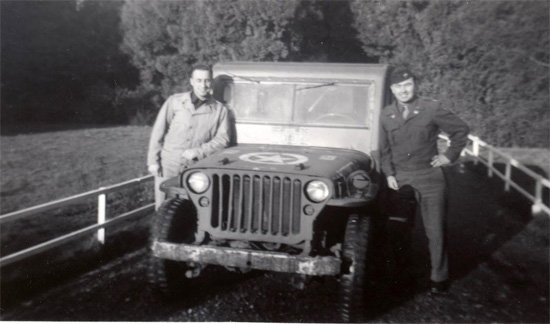
Captains Paul D. Hass and John V. Richardson, Sr., pose in front of their 1/4-ton truck in Sudbury, England. Photograph taken in May-June 1945. Courtesy of John V. Richardson, Jr.
Total Miscellaneous Operations & Tests – the following number of tests were performed during the same period, starting 16 May 1944 and terminating 31 October 1944:
Hematology – 15,605 tests; Urinalysis – 16,654 tests; Biochemistry – 2,432 tests; Serology – 4,468 tests; Pathology – 1,081 tests; Bacteriology – 881 cultures; Smears – 3,386 samples; Stools – 797 smears; Fungi – 299 smears & cultures; Agglutination – 69 tests; Misc. Tests – 152.
The X-Ray Service consisting of 2 Officers assisted by 12 Technicians, responsible for reception, administration, maintenance and repair, handled a total of 6,407 patients and performed 7,329 examinations. The patients examined consisted of 1,964 out cases.
As from 16 May 1944, the Laboratory Service replaced the lab personnel of the 108th General Hospital operating part of Hospital Plant 4187. The service consisted of 3 Officers including Major Colin F. Vorder Bruegge, MC, Captain Malcolm B. Melroy, SnC, and 1st Lieutenant Irving Rosefield, SnC, and 16 Medical, Surgical, and Laboratory Technicians, assisted by clerks, and typists. All those people were graduates of Army Laboratory Schools. From 1 January 1945 throughout 31 May 1945, 22,550 tests were performed in this laboratory.
The Dental Service, housed in a separate building, included 6 professional Officers assisted by 3 Noncommissioned Officers and 11 Dental and Laboratory Technicians. It handled a total of 5,250 routine admissions, 679 emergency admissions, and 11,546 sittings. Furthermore, it replaced 1,189 teeth with dentures or bridges and performed 1,748 x-ray exposures. Between 1 January 1945 and 31 May 1945, the statistics read: 3,707 routine admissions, 445 emergency admissions, and 7,867 sittings.
Termination of Operation:
On 1 June 1945, the Hospital had a census of 536 patients. It was known at this time that the evacuation of all patients out of the 182d Gen Hosp and the closing down of the plant was to occur soon. The 182d General Hospital was finally closed on 11 June 1945, at Sudbury Park, Derbyshire, per Para. 2, Confidential Letter, Hq ETOUSA, Subject: Opening and Closing of Hospitals, File AG 323.3 OpMC, dated 18 June 1945 (although all patients were not evacuated until later and Detachment A, still set up at Lichfield, would only close for operations on 22 June 1945, as officially reported by Headquarters, ETOUSA, on 25 June 1944).
By 13 June, the census was 600 patients, by 15 June 350 patients, and on 16 June 225 patients remained. Orders were received from the 804th Hospital Center to transfer all patients to other nearby hospitals, and this mass evacuation was finally accomplished prior to 2400 hours, 16 June 1945.

Officers of the 182d during the 1944/1945 winter in England, from left to right: Robert W. Laurrell, Edward D. McKenna, Melvin D. Gulley, and Paul D. Hass.
Courtesy of Chris Clippinger.
On 28 June 1945, Colonel L. Kirkpatrick, MC, O-18642 relinquished command of the organization, having received orders to report to the 188th General Hospital for duty, effective 5 July. Lieutenant Colonel Dale C. McCarty, MC, O-311714 assumed the additional duty as Acting CO, and on 28 June 1945, Colonel Milton I. Strahl, MC, O-209938, coming from the 306th Station Hospital reported for duty as the new Commanding Officer on 5 July 1945. Screening of personnel progressed steadily since 1 July the major portion of men had been transferred to units in the Army of Occupation or to units leaving the United Kingdom for the United States at a later date. Redeployment Alert Orders No. 299, Headquarters United Kingdom Base, File AG 370.5 OpGC, dated 8 September 1945 were received establishing the 182d Gen Hosp in Category IV; later the readiness date was set as 8 October 1945. Numerous personnel changes followed and involved all types. Approximately 98% of the entire personnel was ordered and replaced with different people, above the critical ASR score of 70 points and 35 years of age and over. Also Officers changed. Colonel M. I. Strahl was assigned to the 52d General Hospital on 4 September, and Lieutenant Colonel D. C. McCarty again resumed command of the 182d until placed on temporary duty with the 168th Station Hospital. Lieutenant Colonel Gordon C. MacRae, MC, O-289117 replaced the latter on 21 September, until placed on temporary duty aboard the “Queen Mary” bound for the United States as Medical Attendant. In the end, a new CO was assigned to the organization from the 185th General Hospital on 3 November 1945, namely Lieutenant Colonel Clarence F. Albers, DC, O–140774.
Further changes occurred, and the 182d Gen Hosp was relieved from assignment to the 804th Hospital Center (Whitchurch) to the 12th Hospital Center (Great Malvern), effective 9 July. The entire unit left its station at 0800 hours and arrived at the 106th General Hospital, Wimborne, the same day. Changes continued, and the previous assignment to the 804th HC was terminated and replaced by one to the 802d Hospital Center (Blandford), and once more by another to the 805th Hospital Center, APO 519-A (Newmarket), by 6 August 1945. Station locations also suffered changes, and transfers took place from Wimborne, Dorsetshire, to Blandford Camp, Dorsetshire, and to the Tidworth Staging Area, Wiltshire, where the unit eventually arrived at 1300 hours, 16 October 1945. On 15 November 1945 the unit was still at this last location, for final staging purposes and waiting for return to the United States…

Photograph showing the wedding party of Paul D. Hass (QMC), Virginia L. Tourgee (ANC), Mary Cook (ANC) and John V. Richardson, Sr. (CE) August 1945.
Courtesy of Chris Clippinger.
Meanwhile, it should be mentioned that all personnel of the 682d General Hospital Complementary Unit (part of the 182d Gen Hosp) had been transferred to the 687th General Hospital Complementary Unit, APO 648 (CO > Captain Rudolph J. Seadal, MAC, O-1544308) which was composed of colored personnel whose point scores were way below the minimum requirement for immediate shipment and return to the United States. Substitution of white personnel for colored was accomplished, and the unit brought up to strength, and processed. They were also waiting for the port call …
Campaigns – 182d General Hospital
no campaign credits – served and remained in the United Kingdom
Special Note: The 182d Gen Hosp contributed £ 101 (over US$ 400.00) to the “War Orphan Fund” sponsored by the ‘Stars and Stripes’ – a 7-year old lad, a British orphan, was selected and received benefits from this contribution. This entire benevolent action took place during the months of February, March, and April of 1945 and represented contributions made by patients and personnel of the Hospital.

Certificate of Good Will, supplied by The “Stars & Stripes” War Orphans Fund to the 182d General Hospital in April 1945 for having sponsored a British war orphan.
The boy – Roger C – case no. 1220, was born on 24 April 1938. He had lost his mother in February 1939 and his father in February 1941. He was taken under the care of the British Ministry of Pensions and boarded out to a British family; Mr. and Mrs. Mills. The boy was selected and assigned on 3 April 1945.
Postwar: in November 1948, Fifth United States Army Headquarters requested Lt. Colonel Leo R. Weinshel, to initiate the organization of a 1000-bed hospital in Milwaukee, Wisconsin, United States, to be designated the 452d General Hospital. The unit was formally established 1 February 1949, as a re-designation and re-organization of the former 182d General Hospital, inactivated in 1945 at Camp Kilmer, New Jersey (many of the new 452d Gen Hosp personnel had served with the 182d General Hospital in the European Theater –ed).

Officers of the 182d General Hospital who formed the wedding party pose for the camera. From left to right: John V. Richardson, Sr., Melvin D. Gulley, unknown ANC Officer, Virginia L. Tourgee, Edward D. McKenna, Joseph Sciortino. The occasion was the marriage of Captain Paul D. Hass with First Lieutenant Virginia Lee Tourgee, which took place 15 August 1945 in Wimborne, Dorset, England.
Courtesy of Chris Clippinger.
We would like to express our sincere thanks to Robert D. Wall who generously provided us with vintage copies of reports covering the 182d General Hospital while in training in the Zone of Interior and in operation in the European Theater. His assistance greatly helped us edit the Hospital’s Unit History. We must not forget Chris Clippinger, daughter of Captain Paul D. Hass, QMC (O-1588035) as well as John V. Richardson, Jr., son of Captain John V. Richardson, Sr., CE (O-1588250) Officers who both served with subject unit. We are still looking for the Hospital’s activation date and complete personnel rosters. Thank you.
